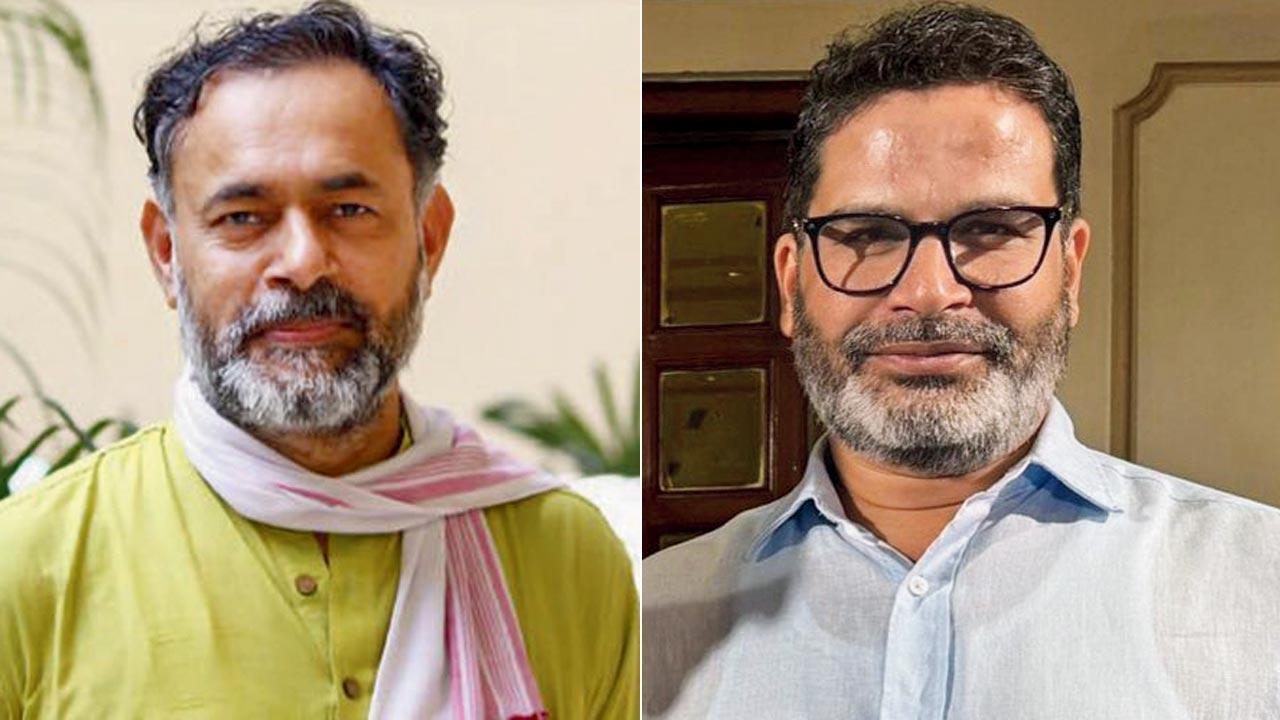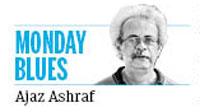We have become nervous wrecks trying to predict the outcome of the ongoing elections. It must be remembered that every election is understood after the results, not before

Former psephologist Yogendra Yadav and political consultant Prashant Kishor have provided opposing estimates of BJP’s tally of seats. Pics/x
 A relative from Bihar called me up a month ago and said there was a wave in favour of Tejashwi Yadav’s Rashtriya Janata Dal. I quipped, “You must have spoken to only Muslims, who see double the number of people actually present in an Opposition rally.” Deep, indeed, runs the desire of Muslims to see the Bharatiya Janata Party voted out. “No, no,” he protested, claiming his conclusion was based on his conversations with acquaintances belonging to the Other Backward Classes who were not Yadav.
A relative from Bihar called me up a month ago and said there was a wave in favour of Tejashwi Yadav’s Rashtriya Janata Dal. I quipped, “You must have spoken to only Muslims, who see double the number of people actually present in an Opposition rally.” Deep, indeed, runs the desire of Muslims to see the Bharatiya Janata Party voted out. “No, no,” he protested, claiming his conclusion was based on his conversations with acquaintances belonging to the Other Backward Classes who were not Yadav.
How many people could my relative have spoken to—20, at best? This number is insufficient to gauge the direction in which the political wind is blowing. Curious, I asked journalists in Bihar for their predictions. Eight to 10 for the RJD, one said. At least 15, another insisted. Curious, I asked an RJD leader whether the BJP-led National Democratic Alliance would drop seats in Bihar. “It will, but don’t ask me to quantify it,” he chuckled. The NDA bagged 39 out of 40 seats in Bihar in 2019.
A loss of, say, three or five seats would still be a loss, but that cannot dramatically alter the NDA’s national tally. It would, however, be significant if the NDA’s tally were to decline by 15 seats.
Welcome to the insane art of predicting election results, engaged in individually or collectively. Its pursuit turns all feverish before every general election. But this time round the fever has assumed epidemical proportion largely because the NDA won maximum or near maximum seats in a string of states in 2019. With political pundits claiming there is no discernible wave for the BJP-led NDA or the Congress-spearheaded INDIA, it does not require a psephologist to predict that the NDA’s 2019 tally will dip.
But the skill in predicting the 2024 results lies in quantifying the losses the NDA could suffer or the gains the Opposition might make. Since practitioners of the art are not trained psephologists, they allocate seats to competing alliances on the basis of media stories on the election mood prevailing in different states. And because the TV is now universally suspected of being biased, they also rely on their favourite YouTuber’s perception for their calculations.
Individuals furiously debate with themselves or with others as they undertake the exercise of apportioning seats among the competing alliances. Often, such are the conversations: Deduct 15 from the NDA’s 2019 tally of 41 in Maharashtra, for there is consensus that the political situation there is fluid. Why not split Maharashtra’s 48 seats equally between the Opposition and the ruling alliance? Give 10-12 seats to the Congress in Karnataka, where it had bagged just one in 2019 and won, last year, the Assembly elections. Wait, could not the BJP’s alliance with the Janata Dal (Secular) make them more competitive now, for last year each fought the Assembly elections alone? Alright, give the Congress just five seats.
Journalists are supposed to be adept at the art of predicting results, for they have the benefit of the information their mates gather on election tours. Of the journalists I spoke to in West Bengal, some said the BJP would gain seats, given the Trinamool’s entanglement in scams. Fine, then, give the BJP 25 seats, up from the 18 it won in 2019. But why not 30? That is because a few think the BJP lost the momentum during the election campaign. Play it safe and split Bengal’s 42 seats equally between the two parties, then!
Just how many voters must a journalist speak to before s/he can be relied upon to read the elections correctly? A hundred in each constituency, or 200? Is it possible to quantify the passion displayed in election rallies? The crowd in Phulpur broke through the barricades to greet Akhilesh Yadav and Rahul Gandhi. So, is Uttar Pradesh vulnerable to the Opposition’s sallies?
It will be good to remember that those who desire change are more vocal and visible than the people content with the status quo.
Former psephologist Yogendra Yadav has been writing and speaking persuasively about the impressions he gathered from his election travels. Yadav said he would ask the people he met whether they would vote for the same party they did in 2019. A high percentage of BJP voters of 2019 told Yadav they will not. His prediction that the BJP will be well below the majority mark lit the candle of hope in some and prompted all to review their calculations.
Yadav’s predictions are not based on a scientific survey, but people take him seriously because of his past as a psephologist. Some accuse him of exploiting his reputation to fight the battle of perception on behalf of the Congress. Would Yadav dissimulate and risk his credibility? A counter to Yadav is political consultant Prashant Kishor, who belatedly emerged to insist the BJP will win a majority on its own. He is accused of batting for the BJP.
Are you confused over your poll arithmetic? Eeny, meeny, miny, moe…choose the number you wish for! Or remember late President Pranab Mukherjee’s profound observation: Every election is understood only after the results.
The writer is a senior journalist
Send your feedback to mailbag@mid-day.com
The views expressed in this column are the individual’s and don’t represent those of the paper
 Subscribe today by clicking the link and stay updated with the latest news!" Click here!
Subscribe today by clicking the link and stay updated with the latest news!" Click here!










